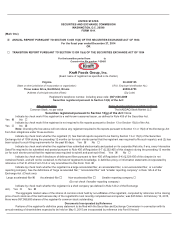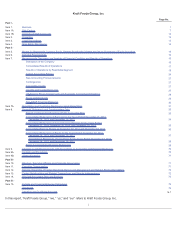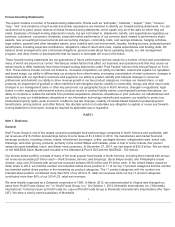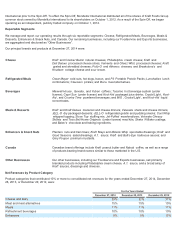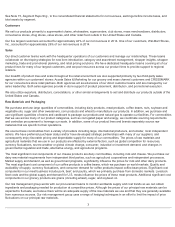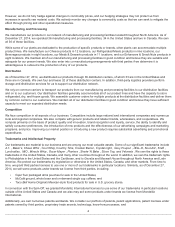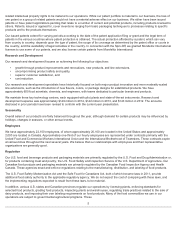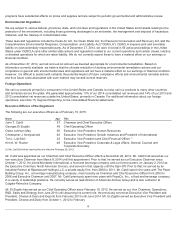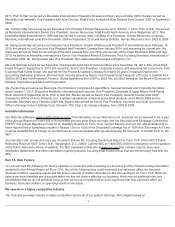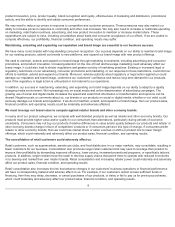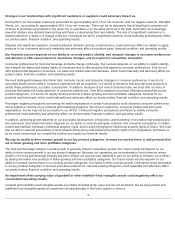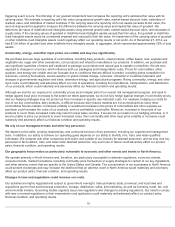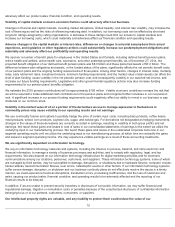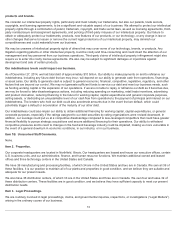Kraft 2014 Annual Report Download - page 7
Download and view the complete annual report
Please find page 7 of the 2014 Kraft annual report below. You can navigate through the pages in the report by either clicking on the pages listed below, or by using the keyword search tool below to find specific information within the annual report.
See Note 15, Segment Reporting , to the consolidated financial statements for net revenues, earnings before income taxes, and
total assets by segment.
Customers
We sell our products primarily to supermarket chains, wholesalers, supercenters, club stores, mass merchandisers, distributors,
convenience stores, drug stores, value stores, and other retail food outlets in the United States and Canada.
Our five largest customers accounted for approximately 42% of our net revenues in 2014. One of our customers, Wal-Mart Stores,
Inc., accounted for approximately 26% of our net revenues in 2014.
Sales
Our direct customer teams work with the headquarter operations of our customers and manage our relationships. These teams
collaborate on developing strategies for new item introduction, category and assortment management, shopper insights, shopper
marketing, trade and promotional planning, and retail pricing solutions. We have dedicated headquarter teams covering all of our
product lines for many of our largest customers, and we pool resources across our product lines to provide support to regional
retailers.
Our breadth of product lines and scale throughout the retail environment are also supported primarily by two third-party sales
agencies within our customers’ stores: Acosta Sales & Marketing for our grocery and mass channel customers and CROSSMARK
for our convenience store retail partners. Both agencies act as extensions of our direct customer teams and are managed by our
sales leadership. Both sales agencies provide in-store support of product placement, distribution, and promotional execution.
We also utilize exporters, distributors, consolidators, or other similar arrangements to sell and distribute our products outside of the
United States and Canada.
Raw Materials and Packaging
We purchase and use large quantities of commodities, including dairy products, meat products, coffee beans, nuts, soybean and
vegetable oils, sugar and other sweeteners, corn products and wheat to manufacture our products. In addition, we purchase and
use significant quantities of resins and cardboard to package our products and natural gas to operate our facilities. For commodities
that we use across many of our product categories, such as corrugated paper and energy, we coordinate sourcing requirements
and centralize procurement to leverage our scale. In addition, some of our product lines and brands separately source raw
materials that are specific to their operations.
We source these commodities from a variety of providers including large, international producers, and smaller, local independent
sellers. We have preferred purchaser status and/or have developed strategic partnerships with many of our suppliers, and
consequently enjoy favorable pricing and dependable supply for many of our commodities. The prices of raw materials and
agricultural materials that we use in our products are affected by external factors, such as global competition for resources,
currency fluctuations, severe weather or global climate change, consumer, industrial or investment demand, and changes in
governmental regulation and trade, alternative energy, and agricultural programs.
The most significant cost components of our cheese products are dairy commodities, including milk and cheese. We purchase our
dairy raw material requirements from independent third parties, such as agricultural cooperatives and independent processors.
Market supply and demand, as well as government programs, significantly influence the prices for milk and other dairy products.
The most significant cost component of our coffee products is coffee beans, which we purchase on world markets. Quality and
availability of supply, currency fluctuations, and consumer demand for coffee products impact coffee bean prices. Significant cost
components in our meat business include pork, beef, and poultry, which we primarily purchase from domestic markets. Livestock
feed costs and the global supply and demand for U.S. meats influence the prices of these meat products. Additional significant cost
components in our grocery products are grains (including wheat), sugar, and soybean oil.
Our risk management group works with our procurement teams to monitor worldwide supply and cost trends so we can obtain
ingredients and packaging needed for production at competitive prices. Although the prices of our principal raw materials can be
expected to fluctuate, we believe there will be an adequate supply of the raw materials we use and that they are generally available
from numerous sources. Our risk management group uses a range of hedging techniques in an effort to limit the impact of price
fluctuations on our principal raw materials.
3

